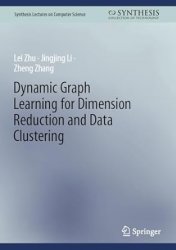 Название: Dynamic Graph Learning for Dimension Reduction and Data Clustering
Название: Dynamic Graph Learning for Dimension Reduction and Data ClusteringАвтор: Lei Zhu, Jingjing Li, Zheng Zhang
Издательство: Springer
Серия: Synthesis Lectures on Computer Science
Год: 2024
Страниц: 162
Язык: английский
Формат: pdf (true), epub
Размер: 18.8 MB
This book illustrates how to achieve effective dimension reduction and data clustering. The authors explain how to accomplish this by utilizing the advanced dynamic graph learning technique in the era of big data. The book begins by providing background on dynamic graph learning. The authors discuss why it has attracted considerable research attention in recent years and has become well recognized as an advanced technique. After covering the key topics related to dynamic graph learning, the book discusses the recent advancements in the area. The authors then explain how these techniques can be practically applied for several purposes, including feature selection, feature projection, and data clustering.
This groundbreaking book represents the first comprehensive exploration of dynamic graph learning. It delves into the modeling of data correlations through adaptive learning of similarity graphs and the extraction of low-dimensional feature vectors that preserve the underlying data structure via spectral embedding and eigendecomposition. Moreover, this book encompasses various subsequent learning tasks within this transformed feature space. Serving as a systematic introduction to dynamic graph learning for dimension reduction and data clustering, it provides an in-depth survey of current advancements and the state-of-the-art in this burgeoning research field.
Notably, this book not only presents the core concepts and methodologies of dynamic graph learning but also elucidates its practical applications in dimension reduction and data clustering. By summarizing recent developments and offering introductory studies on dynamic graph learning for dimension reduction and clustering, this book equips researchers with a comprehensive understanding of crucial issues and serves as an excellent entry point for further exploration in this area of research.
Drawing inspiration from the ability of graphs to model correlations between data points, researchers have introduced graph theory into Machine Learning, particularly in the realm of unsupervised learning tasks. By leveraging graph theory, the similarity matrix of sample data is utilized to decompose features, projecting the original high-dimensional data into a structured and expressive feature vector space. This graph-based feature representation enables effective support for dimensionality reduction and data clustering tasks. While graph learning has made significant strides in the past few decades, challenges remain in the areas of dimension reduction and data clustering.
Скачать Dynamic Graph Learning for Dimension Reduction and Data Clustering